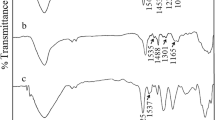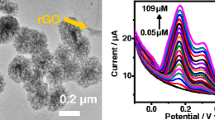Abstract
We report on an amperometric biosensor for hydrogen peroxide. It is obtained via layer-by-layer assembly of ordered mesoporous carbon nanospheres and poly(diallyldimethylammonium) on the surface of an indium tin oxide (ITO) glass electrode and subsequent adsorption of cytochrome c. UV–vis absorption spectroscopy was applied to characterize the process of forming the assembled layers. Cyclic voltammetry revealed a direct and quasi-reversible electron transfer between cytochrome c and the surface of the modified ITO electrode. The surface-controlled electron transfer has an apparent heterogeneous electron-transfer rate constant (k s ) of 5.9 ± 0.2 s−1 in case of the 5-layer electrode. The biosensor displays good electrocatalytic response to the reduction of H2O2, and the amperometric signal increase steadily with the concentration of H2O2 in the range from 5 μM to 1.5 mM. The detection limit is 1 μM at pH 7.4. The apparent Michaelis-Menten constant (K m ) of the sensor is 0.53 mM. We assume that the observation of a direct electron transfer of cytochrome c on mesoporous carbon nanospheres may form the basis for a feasible approach for durable and reliable detection of H2O2.

An amperometric biosensor for hydrogen peroxide has been fabricated via layer-by-layer assembly of mesoporous carbon nanospheres and polyelectrolyte on ITO electrode surface for the adsorption of cytochrome c. The direct electrochemistry and electrocatalytic activity of cytochrome c was achieved on the multilayer-assembled electrode, indicating a good affinity and biocompatibility of mesoporous carbon nanospheres for cytochrome c.






Similar content being viewed by others
References
Hall ED, Braughler JM (1989) Central nervous-system trauma and stroke II. Physiological and pharmacological evidence for involvement of oxygen radicals and lipid-peroxidation. Free Radical Bio Med 6:303–313
Park BW, Yoon DY, Kim DS (2010) Recent progress in bio-sensing techniques with encapsulated enzymes. Biosens Bioelectron 26:1–10
Song J, Xu JM, Zhao PS, Lu LD, Bao JC (2011) A hydrogen peroxide biosensor based on direct electron transfer from hemoglobin to an electrode modified with Nafion and activated nanocarbon. Microchim Acta 172:117–123
Yagati AK, Lee T, Min J, Choi JW (2012) Electrochemical performance of gold nanoparticle–cytochrome c hybrid interface for H2O2 detection. Colloids Surf B Biointerfaces 92:161–167
Xu Q, Mao C, Liu NN, Zhu JJ, Sheng J (2006) Direct electrochemistry of horseradish peroxidase based on biocompatible carboxymethyl chitosan-gold nanoparticle nanocomposite. Biosens Bioelectron 22:768–773
Huang JM, Zheng JB, Sheng QL (2011) Direct electrochemistry of myoglobin based on electrodeposition of Pd nanoparticles with carbon ionic liquid electrode as basic electrode. Microchim Acta 173:157–163
Xu SX, Zhang XF, Wan T, Zhang CX (2011) A third-generation hydrogen peroxide biosensor based on horseradish peroxidase cross-linked to multi-wall carbon nanotubes. Microchim Acta 172:199–205
Wang Y, Qian K, Guo K, Kong JL, Marty JL, Yu CZ et al (2011) Electrochemistry and biosensing activity of cytochrome c immobilized in macroporous materials. Microchim Acta 175:87–95
Lu F, Wu SH, Hung Y, Mou CY (2009) Size effect on cell uptake in well-suspended, uniform mesoporous silica nanoparticles. Small 5:1408–1413
Li C (2004) Chiral synthesis on catalysts immobilized in microporous and mesoporous materials. Catal Rev 46:419–492
Lu ZD, Ye MM, Li N, Zhong WW, Yin YD (2010) Self-assembled TiO2 nanocrystal clusters for selective enrichment of intact phosphorylated proteins. Angew Chem Int Ed 49:1862–1866
Slowing II, Vivero-Escoto JL, Wu CW, Lin VSY (2008) Mesoporous silica nanoparticles as controlled release drug delivery and gene transfection carriers. Adv Drug Deliver Rev 60:1278–1288
Kim TW, Chung PW, Slowing II, Tsunoda M, Yeung ES, Lin VSY (2008) Structurally ordered mesoporous carbon nanoparticles as transmembrane delivery vehicle in human cancer cells. Nano Lett 8:3724–3727
Yan AH, Lau BW, Weissman BS, Kulaots I, Yang NYC, Kane AB et al (2006) Biocompatible, hydrophilic, supramolecular carbon nanoparticles for cell delivery. Adv Mater 18:2373–2378
Fang Y, Gu D, Zou Y, Wu ZX, Li FY, Che RC et al (2010) A low-concentration hydrothermal synthesis of biocompatible ordered mesoporous carbon nanospheres with tunable and uniform size. Angew Chem Int Ed 49:7987–7991
Zheng LZ, Yao X, Li JH (2006) Layer-by-layer assembly films and their applications in electroanalytical chemistry. Curr Anal Chem 2:279–296
Tedeschi C, Li LD, Mohwald H, Spitz C, von Seggern D, Menzel R et al (2004) Engineering of layer-by-layer coated capsules with the prospect of materials for efficient and directed electron transfer. J Am Chem Soc 126:3218–3227
Shi GY, Sun ZY, Liu MC, Zhang L, Liu Y, Qu YH et al (2007) Electrochemistry and electrocatalytic properties of hemoglobin in layer-by-layer films of SiO2 with vapor-surface sol–gel deposition. Anal Chem 79:3581–3588
Feng JJ, Xu JJ, Chen HY (2007) Direct electron transfer and electrocatalysis of hemoglobin adsorbed on mesoporous carbon through layer-by-layer assembly. Biosens Bioelectron 22:1618–1624
George P, Hanania G (1953) A spectrophotometric study of ionizations in methaemoglobin. Biochem J 55:236–243
Hawkridg FM, Kuwana T (1973) Indirect coulometric titration of biological electron-transport components. Anal Chem 45:1021–1027
Wang SF, Chen T, Zhang ZL, Shen XC, Lu ZX, Pang DW et al (2005) Direct electrochemistry and electrocatalysis of heme proteins entrapped in agarose hydrogel films in room-temperature ionic liquids. Langmuir 21:9260–9266
Kuznetsov BA, Byzova NA, Shumakovich GP (1994) The effect of the orientation of cytochrome-c molecules covalently attached to the electrode surface upon their electrochemical activity. J Electroanal Chem 371:85–92
Laviron E (1979) General expression of the linear potential sweep voltammogram in the case of diffusionless electrochemical systems. J Electroanal Chem 101:19–28
Deng ZF, Gong YC, Luo YP, Tian Y (2009) WO3 nanostructures facilitate electron transfer of enzyme: application to detection of H2O2 with high selectivity. Biosens Bioelectron 24:2465–2469
Yu T, Zhang YH, You CP, Zhuang JH, Wang B, Liu BH et al (2006) Controlled nanozeolite-assembled electrode: remarkable enzyme-immobilization ability and high sensitivity as biosensor. Chem-Eur J 12:1137–1143
Zhu L, Wang KQ, Lu TH, Xing W, Li J, Yang XG (2008) The direct electrochemistry behavior of Cyt c on the modified glassy carbon electrode by SBA-15 with a high-redox potential. J Mol Catal B: Enzym 55:93–98
Zhao GC, Yin ZZ, Zhang L, Wei XW (2005) Direct electrochemistry of cytochrome c on a multi-walled carbon nanotubes modified electrode and its electrocatalytic activity for the reduction of H2O2. Electrochem Commun 7:256–260
Kamin RA, Wilson GS (1980) Rotating-ring-disk enzyme electrode for biocatalysis kinetic-studies and characterization of the immobilized enzyme layer. Anal Chem 52:1198–1205
Wu KB, Hu SS (2004) Electrochemical study and selective determination of dopamine at a multi-wall carbon nanotube-Nafion film coated glassy carbon electrode. Microchim Acta 144:131–137
Wang BZ, Du XY, Wang MQ, Gong WL, Anzai J (2008) A facile preparation of H2O2 sensors using layer-by-layer deposited thin films composed of poly(ethyleneimine) and carboxymethyl cellulose as matrices for immobilizing hemin. Electroanal 20:1028–1031
Xie Y, Liu HY, Hu NF (2007) Layer-by-layer films of hemoglobin or myoglobin assembled with zeolite particles: Electrochemistry and electrocatalysis. Bioelectrochemistry 70:311–319
Zhang YM, Liu LJ, Xi FN, Wu TX, Lin XF (2010) A simple layer-by-layer assembly strategy for a reagentless biosensor based on a nanocomposite of methylene blue-multiwalled carbon nanotubes. Electroanal 22:277–285
Wang Y, Ma XL, Wen Y, Zheng YQ, Duan GP, Zhang ZR et al (2010) Phytic acid-based layer-by-layer assembly for fabrication of mesoporous gold film and its biosensor application. J Electrochem Soc 157:K5–K9
Li WT, Wang MH, Li YJ, Sun Y, Li JC (2011) Linker-free layer-by-layer self-assembly of gold nanoparticle multilayer films for direct electron transfer of horseradish peroxidase and H2O2 detection. Electrochim Acta 56:6919–6924
Acknowledgments
This work was supported by NSFC (20925517, 21175028) and SKLEAC201101. Y. Wang and X. Bian contributed equally to this work.
Author information
Authors and Affiliations
Corresponding author
Electronic supplementary material
Below is the link to the electronic supplementary material.
ESM 1
(DOC 700 kb)
Rights and permissions
About this article
Cite this article
Wang, Y., Bian, X., Liao, L. et al. Electrochemistry and biosensing activity of cytochrome c immobilized on a mesoporous interface assembled from carbon nanospheres. Microchim Acta 178, 277–283 (2012). https://doi.org/10.1007/s00604-012-0834-1
Received:
Accepted:
Published:
Issue Date:
DOI: https://doi.org/10.1007/s00604-012-0834-1




